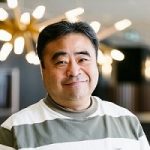Hiroshi Esaki Ph.D received the B.E. and M.E. degrees from Kyushu University, Fukuoka, Japan, in 1985 and 1987, respectively. And, he received Ph.D from The University of Tokyo, Japan, in 1998.
In 1987, he joined Research and Development Center, Toshiba Corporation. From 1990 to 1991, he has been at Applied Research Laboratory of Bellcore Inc., New Jersey (USA), as a residential researcher. From 1994 to 1996, he has been at CTR (Center for Telecommunication Research) of Columbia University in New York (USA). During his staying at Columbia University, he has proposed the CSR architecture, that is the origin of Multi-Protocol Label Switching (MPLS), to the IETF and to the ATM Forum. From 1996 to 1998, he has conducted the CSR project in Toshiba, as a chief architect.
Since 1997, he has involved in the IPv6 research and development at the WIDE project. He is a co-founder of series of IPv6 special project in the WIDE project, i.e.:
KAME project ; IPv6 protocol stack for BSD UNIX
TAHI project ; IPv6 test and evaluation specification and tools
USAGI project ; IPv6 protocol stack for Linux
Regarding the research/development/deployment for the IPv6, he has been very tightly and closely working with Prof. Jun Murai, who has been a political and technical advisor for the Japanese cabinet for more than 15 years. He is an executive director of IPv6 promotion council, which is cross ministry and cross industry council to promote the IPv6 technology. As the activities of IPv6 promotion council, he has established the following working groups, that are aiming to explore and to deploy the IPv6 as the professional and business operation.
Since 2003, he has started the introduction of TCP/IP and Internet Framework into the facility system, which is now identified as SmartGrid, Smart Building, Smart Campus or Smart City. He successfully standardized the TCP/IP based architectural framework as IEEE1888 in IEEE, and proposing to NIST SGIP CoS (Catalogue of Standard) in US and to ISO/IEC JTC1 SC6.
He is a vice chair of Japan Network Information Center (JPNIC), since 2006, and has served as an IPv6 Forum Fellow and chair of IPv6 Ready Logo Program Commitee. From 2006 to 2010, he served as Board of Trustee for Internet Society. He is a director of WIDE Project since 2010, director of Japan Data Center Council since 2009, and director of Green University of Tokyo Project, which is one of the important and killer application of IoT for 21st century, since 2008.
Image credit: © Renaud Philippe
